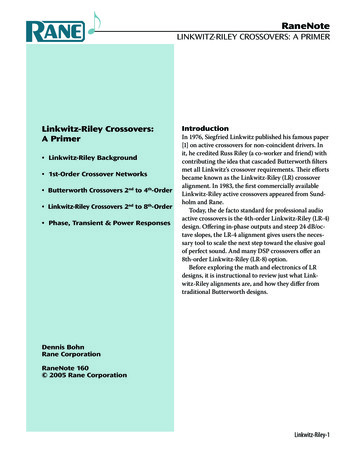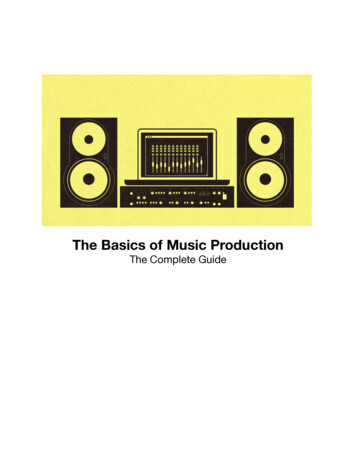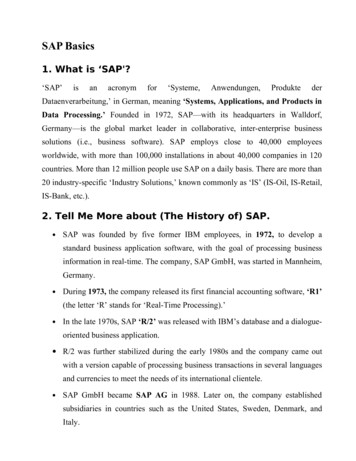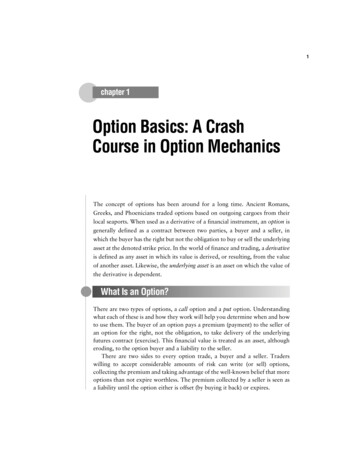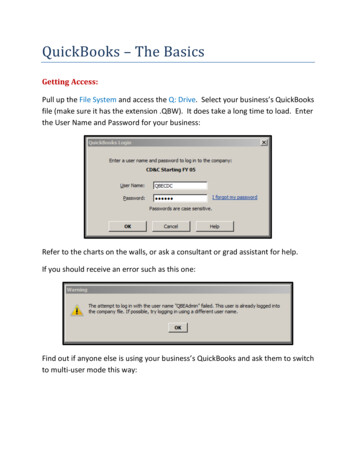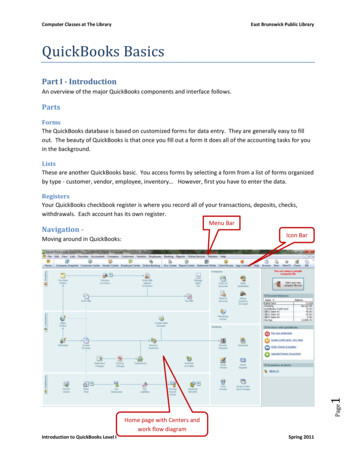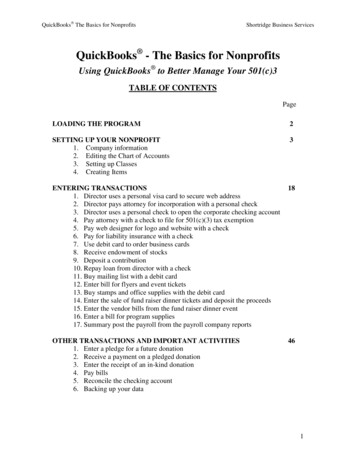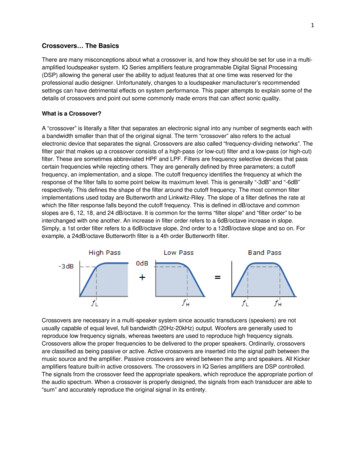
Transcription
1Crossovers The BasicsThere are many misconceptions about what a crossover is, and how they should be set for use in a multiamplified loudspeaker system. IQ Series amplifiers feature programmable Digital Signal Processing(DSP) allowing the general user the ability to adjust features that at one time was reserved for theprofessional audio designer. Unfortunately, changes to a loudspeaker manufacturer’s recommendedsettings can have detrimental effects on system performance. This paper attempts to explain some of thedetails of crossovers and point out some commonly made errors that can affect sonic quality.What is a Crossover?A “crossover” is literally a filter that separates an electronic signal into any number of segments each witha bandwidth smaller than that of the original signal. The term “crossover” also refers to the actualelectronic device that separates the signal. Crossovers are also called “frequency-dividing networks”. Thefilter pair that makes up a crossover consists of a high-pass (or low-cut) filter and a low-pass (or high-cut)filter. These are sometimes abbreviated HPF and LPF. Filters are frequency selective devices that passcertain frequencies while rejecting others. They are generally defined by three parameters; a cutofffrequency, an implementation, and a slope. The cutoff frequency identifies the frequency at which theresponse of the filter falls to some point below its maximum level. This is generally “-3dB” and “-6dB”respectively. This defines the shape of the filter around the cutoff frequency. The most common filterimplementations used today are Butterworth and Linkwitz-Riley. The slope of a filter defines the rate atwhich the filter response falls beyond the cutoff frequency. This is defined in dB/octave and commonslopes are 6, 12, 18, and 24 dB/octave. It is common for the terms “filter slope” and “filter order” to beinterchanged with one another. An increase in filter order refers to a 6dB/octave increase in slope.Simply, a 1st order filter refers to a 6dB/octave slope, 2nd order to a 12dB/octave slope and so on. Forexample, a 24dB/octave Butterworth filter is a 4th order Butterworth filter.Crossovers are necessary in a multi-speaker system since acoustic transducers (speakers) are notusually capable of equal level, full bandwidth (20Hz-20kHz) output. Woofers are generally used toreproduce low frequency signals, whereas tweeters are used to reproduce high frequency signals.Crossovers allow the proper frequencies to be delivered to the proper speakers. Ordinarily, crossoversare classified as being passive or active. Active crossovers are inserted into the signal path between themusic source and the amplifier. Passive crossovers are wired between the amp and speakers. All Kickeramplifiers feature built-in active crossovers. The crossovers in IQ Series amplifiers are DSP controlled.The signals from the crossover feed the appropriate speakers, which reproduce the appropriate portion ofthe audio spectrum. When a crossover is properly designed, the signals from each transducer are able to“sum” and accurately reproduce the original signal in its entirety.
2The Crossover PointThe crossover point is defined as the frequency at which the responses of two filters, usually aHPF and a LPF, cross one another. This can be the crossover point of two filters in an electroniccrossover, or the crossover point of two passive filters. Any speaker is, in fact, also a filter. Every speakerhas its own cutoff frequency, slope, and implementation.Since Kicker IQ Series amplifiers utilize full digital control via Digital Signal Processing, the music ismanipulated in the digital domain without the signal being degraded in any way. Analog to Digital andDigital to Analog conversions are done at the same resolution, therefore, there is no data loss.The crossover sections of all IQ Series amplifiers allow the user to select any frequency from 20 – 20kHz.The slope (roll-off) choices are 6, 12, 18 or 24dB/octave or OFF. Selecting OFF will disable thatcrossover.Linkwitz-Riley or Butterworth?We offer two different crossover options within the Tweeq software. The diagram below shows thedifference between the two implementations. It basically comes down to how the high-pass and low-passfilterssum together at the crossover point. Electronically speaking, a Linkwitz-Riley implementation sumstogether to a flat response at the crossover point and a Butterworth implementation sums with a 3dB riseat the crossover point. However, in a vehicle, drivers could be located almost anywhere, so perfect driverphysical alignment and control of acoustic interaction may not be possible, so all bets are off. The best
3course of action would be to experiment in the vehicle using your favorite music. Select Linkwitz-Rileyand try different crossover points, then select Butterworth and try different crossover points. Pick thesetting that sounds best.Here is a little information that may be helpful when choosing your crossover slope:6dB/octaveFirst-order crossovers have a 6 dB/octave slope and are considered by many audiophiles to be ideal.This is because this filter type is 'transient perfect', It has minimum phase change, but allows moreunwanted signals to pass than do higher order configurations. While woofers can easily take this, smallerhigh frequency drivers (especially tweeters) are more likely to be damaged.In practice, speaker systems with true 6dB/octave slopes are difficult to design because they require largeoverlapping driver bandwidth, and the shallow slopes mean that non-coincident drivers interfere over awide frequency range and cause large response shifts off-axis.12dB/octaveThese have a 12 dB/octave slope and can have Linkwitz-Riley or Butterworth implementation. This orderis commonly used in component set passive crossovers as it offers a reasonable balance betweencomplexity, response, and high frequency driver protection. When designed with time aligned physicalplacement, (drivers mounted on the same baffle) these crossovers have a symmetrical polar response, asdo all even order crossovers. Refer to the section below regarding time alignment.18dB/octaveThird-order filters have an 18 dB/octave slope. These crossovers usually have Butterworth filterimplementation and have a 3db bump at the crossover point.24dB/octaveFourth-order filters have a 24 dB/octave slope. A 24dB/octave crossover with 6 dB crossover point andflat summing is also known as a Linkwitz-Riley crossover (named after its inventors). Butterworth isanother choice in this crossover implementation.A 24dB/octave slope has the potential for a lower crossover point and increased power handling fortweeters, together with less overlap between drivers, reducing unwelcome off-axis effects. With lessoverlap between adjacent drivers, their location relative to each other becomes less critical and allowsmore practical installation possibilities.A few additional thoughts Ordinarily, speaker placement, orientation, distance from each other, etc. are the first hurdle to overcomewhen building and tuning a mobile audio system. Unfortunately, most vehicles make this job extremelydifficult.
4Kicker IQ Series amplifiers are audiophile quality, fully functional amplifiers right out of the box. Allcontrols necessary for setting up a great audio system are on the end panel.But If you want to really take your system to the next level, IQ Series amplifiers provide far more controlover typical amp parameters like crossovers and basic equalization. One very powerful feature is timealignment. All you will need to access these additional features is our free TWEEQ software, a mini-USBcable and a computer. Simply measure the distance from each speaker to your ear, enter thesemeasurements into the TWEEQ program, and basic time alignment settings are made for you. You canalways “TWEEQ” the computers results to further fine tune your system.Speaker protectionAll mobile audio packaged component sets provide passive crossover networks optimized for thespeakers in the kit. The provided crossover slops are generally 12dB/octave. These crossovers usuallyprovide some type of tweeter protection. If the decision is made to “go fully active” using the amplifiersinternal crossovers instead of the passive crossovers supplied with the component set, the protectionprovided with the components will not be able to protect your tweeters. This is where crossover point andslope selection in the IQ amp can help.Generally speaking, lowering the crossover point for a tweeter will allow it to blend better with a midrange.Unfortunately, lowering the tweeter crossover point will reduce its power handling. This can becompensated for by increasing the slope of the tweeter crossover. If you are happy with themanufacturers recommended crossover point, you can increase the tweeters power handling byincreasing the tweeter crossovers slope and/or raising the crossover point. This also holds true for amidrange or mid bass speaker.Overlapping and underlappingThe crossover section of the IQ Series amplifier allows you to overlap or underlap crossover points. Whatthe heck is this? Say you have a four channel IQ amplifier and are running a pair of components fullyactive. Amp 1 is running a pair of front tweeters and Amp 2 is running a pair of midrange drivers. The leftfront high-pass crossover is set to 3500Hz. The right front high-pass is also set to 3500Hz. The left andright rear mid-range crossovers of Amp 2 are set for a band-pass of 100Hz to 3500Hz. If the low-pass(upper limit) portion of the mid-range driver’s band-pass is raised to 4000Hz, it will “overlap” the high-passfrequency setting of the tweeter high-pass from 3500 to 4000Hz. This will result in increased outputbetween 3500 and 4000Hz. If the Low-pass portion of the midrange band-pass is lowered to 2500Hz,there will be a gap in the frequency response between 2500 and 3500Hz resulting in a drop in output.This is referred to as “underlap”. These are just a few more tips that can be helpful when fine tuning yoursystem. IQ’s powerful internal DSP allows great flexibility.
5In conclusion Crossover setting can be one of the most frustrating aspects of audio system tuning. Many things need tobe considered when dialing them in. Kicker has made this task much simpler with our IQ Seriesamplifiers. Our TWEEQ software quick start menu will allow you to answer a few questions and enter afew measurements resulting in the starting point for an unbelievably great sounding audio system.IQ Series amplifiers allow you to “open up” your tuning choices. DSP provides flexibility. Practicality, easeof use and a very high cost/performance ratio gets you the most out of your audio components.David E. GumiennyKickerCredits:I would like to thank Nathan Butler, Design Engineer for EAW (Eastern Acoustic Works) for allowing me touse portions of his “Processor Setting Fundamentals” paper.
crossover, or the crossover point of two passive filters. Any speaker is, in fact, also a filter. Every speaker has its own cutoff frequency, slope, and implementation. Since Kicker IQ Series amplifiers utilize full digital control via Digital Signal Processing, the music is manipulated in the digital domain without the signal being degraded in any way. Analog to Digital and Digital to Analog .
